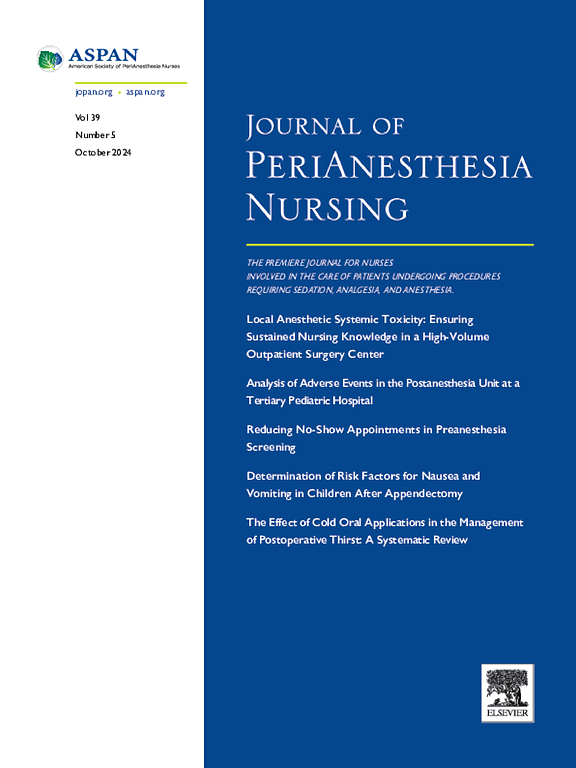一项非随机前瞻性干预研究:腹大手术患者走进手术室时,预温对围手术期意外低温的患病率及影响
IF 2
4区 医学
Q2 NURSING
引用次数: 0
摘要
目的:本研究的目的是确定术前和不术前预热围手术期意外低温的发生率,并评估预热对腹部大手术患者走向手术室(OR)的核心温度的影响。设计:一项非随机前瞻性干预研究。方法:参与者是计划进行腹部大手术并步行到手术室的患者。对照组在手术过程中使用强制空气加热系统,干预组在围手术期使用强制空气加热系统。在到达手术室时、麻醉诱导后、手术期间和到达麻醉后护理单元(PACU)时每隔30分钟评估一次核心温度。结果:对照组30例,干预组30例。干预组5例(16.7%),对照组19例(63.6%)围手术期出现低温。干预组从麻醉诱导后30分钟到到达麻醉后护理病房,体温过低的发生率明显降低。预热减少了核心温度的下降。结论:预温方法联合术中主动加热加强制空气加热,可减少围手术期患者核心温度下降和围手术期意外低温发生率。本文章由计算机程序翻译,如有差异,请以英文原文为准。
The Prevalence and Effect of Prewarming on Unintentional Perioperative Hypothermia in Patients Undergoing Major Abdominal Surgery Walking to the Operating Room: A Non-randomized Prospective Intervention Study
Purpose
The purpose of the study was to determine the prevalence of unintentional perioperative hypothermia with and without preoperative warming and evaluate the effect of prewarming on core temperature in patients undergoing major abdominal surgery walking to the operating room (OR).
Design
A non-randomized prospective intervention study.
Methods
Participants were patients scheduled for major abdominal surgery and walking to the OR. The control group received a forced-air warming system during the surgery, whereas the intervention group received a forced-air warming system throughout the perioperative period. Core temperature was assessed on arrival to the OR and in 30-minute intervals after induction of anesthesia and during surgery and on arrival at the postanesthesia care unit (PACU).
Findings
Overall, 30 patients were included in the control group and 30 patients in the intervention group. Five patients (16.7%) in the intervention group and 19 patients (63.6%) in the control group were hypothermic at a given time in the perioperative period. The prevalence of hypothermia was significantly lower in the intervention group from 30 minutes after induction of anesthesia until arrival in the postanesthesia care unit. Prewarming reduced the drop in core temperature.
Conclusions
The prewarming method combined with peroperative active warming with forced-air warming in patients walking to the OR reduces the drop in core temperature and the prevalence of unintentional perioperative hypothermia throughout the perioperative period.
求助全文
通过发布文献求助,成功后即可免费获取论文全文。
去求助
来源期刊

Journal of Perianesthesia Nursing
NURSING-
CiteScore
2.20
自引率
17.60%
发文量
279
审稿时长
90 days
期刊介绍:
The Journal of PeriAnesthesia Nursing provides original, peer-reviewed research for a primary audience that includes nurses in perianesthesia settings, including ambulatory surgery, preadmission testing, postanesthesia care (Phases I and II), extended observation, and pain management. The Journal provides a forum for sharing professional knowledge and experience relating to management, ethics, legislation, research, and other aspects of perianesthesia nursing.
 求助内容:
求助内容: 应助结果提醒方式:
应助结果提醒方式:


